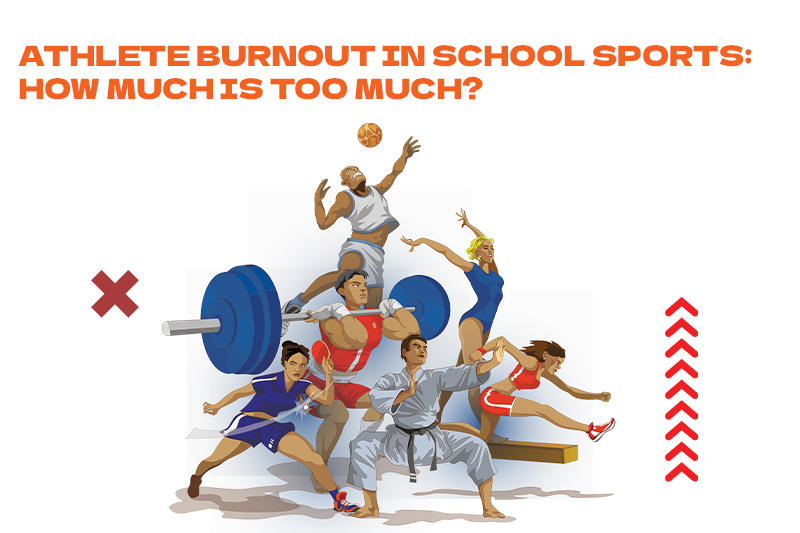Athlete Burnout in School Sports: Signs, Causes & How to Prevent It
How Much Is Too Much?
For many high school athletes, sports aren’t just extracurricular—they’re central to their identity and daily life. Between early practices, late-night games, travel for tournaments, and pressure to perform, the student-athlete experience can be intense.
But as competition increases and expectations rise, a serious question emerges: How much is too much?
Behind the scenes of highlight reels and trophies, many teens are quietly struggling with athlete burnout—a condition that affects both their performance and mental health.
What Is Athlete Burnout?
Burnout is a state of emotional, physical, and mental exhaustion caused by prolonged stress. For student-athletes, this often stems from constant training, high performance expectations, and the pressure to succeed in both academics and athletics.
According to the American Academy of Pediatrics, up to 70% of children quit organized sports by age 13—with burnout being one of the primary reasons. By high school, the problem is even more visible. A 2022 Journal of Adolescent Health study found that 30% of high school athletes report burnout symptoms, including fatigue, anxiety, and lack of motivation.
Key Risk Factors:
- Academic stress
- Overtraining
- Pressure to specialize in one sport
- Fear of disappointing parents or coaches
- Lack of recovery time
The Overtraining Trap: When Passion Turns into Pressure
Most high school athletes are balancing 12 to 15 hours of training per week, on top of a full school schedule. Some exceed this—especially those pursuing elite performance or college recruitment.
This kind of time commitment often comes at the expense of:
- Adequate sleep
- Social activities
- Mental downtime
- Balanced nutrition and recovery
Without rest, the body can’t heal. Without balance, the mind starts to shut down. That’s when burnout sets in.
Early Specialization: A Double-Edged Sword
In the pursuit of college scholarships or competitive edge, many teens are encouraged—or even pressured—to specialize in one sport at an early age. While this might seem like a fast track to success, the research says otherwise.
According to a study by the National Center for Biotechnology Information (NCBI), athletes who focus on a single sport too early are:
- More likely to suffer from overuse injuries
- At higher risk for mental burnout
- More likely to quit sports altogether
In contrast, multi-sport athletes not only stay more engaged but also suffer fewer injuries and report greater enjoyment overall. In fact, the American Academy of Pediatrics reports that playing multiple sports reduces the risk of injury by up to 70%.
The Mental and Emotional Toll
Burnout isn’t just physical. In many cases, the emotional burden is the heaviest.
A 2021 NCAA survey found that 31% of college athletes feel overwhelmed by the pressure of balancing sports, school, and life. High school athletes face similar stress—especially as they strive to meet high expectations from coaches, parents, and themselves.
Common signs of student-athlete burnout include:
- Chronic fatigue or insomnia
- Loss of motivation or enjoyment
- Increased irritability or emotional outbursts
- Anxiety or panic around games or practices
- Decline in academic performance
- Withdrawal from teammates or friends
If left unaddressed, burnout can lead to more serious mental health challenges, including depression, anxiety disorders, and eating issues.
Preventing Burnout: What Coaches, Parents & Schools Can Do
Burnout is preventable. But it requires a culture shift—one that values mental well-being as much as physical performance.
1. Prioritize Rest and Recovery
Coaches should schedule mandatory rest days and off-seasons. The "hours per week = athlete’s age" rule is a good benchmark. For example, a 16-year-old shouldn’t train more than 16 hours per week.
2. Promote Multi-Sport Participation
Encourage athletes to explore different sports during the year. It improves coordination, reduces injury risk, and keeps their love for the game alive.
3. Normalize Conversations About Stress
Athletes should feel safe to express when they’re feeling overwhelmed. Coaches and parents can create an open dialogue by checking in regularly and asking more than just performance-based questions.
4. Support Mental Health
Schools should provide access to counseling, peer support groups, and mental health workshops tailored to student-athletes. Education around topics like stress management and mindfulness can go a long way.
5. Redefine Success
Shift the focus from just winning or scholarship potential to personal growth, enjoyment, and team-building. Celebrate effort and progress, not just outcomes.
A Healthier Future for Youth Sports
Sports should build resilience, discipline, confidence, and joy—not exhaustion and emotional breakdowns. Burnout doesn’t have to be part of the student-athlete experience.
With the right guidance and support from parents, coaches, and schools, student-athletes can pursue excellence without sacrificing their well-being. By recognizing the signs early, setting healthy limits, and encouraging open communication, we can help teens find long-term success—and happiness—in both sports and life.
Final Thought
Athlete burnout in school sports is real, but it's not inevitable. By listening more closely to what student-athletes are telling us—through their words and behavior—we can change the game for the better. After all, no trophy is worth a teenager’s health.






